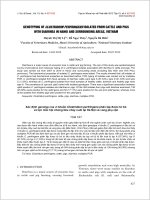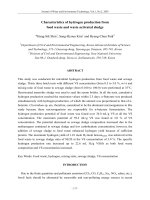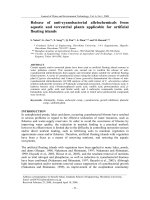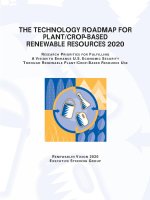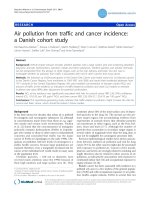Biogas from waste and renewable resources
Bạn đang xem bản rút gọn của tài liệu. Xem và tải ngay bản đầy đủ của tài liệu tại đây (5.03 MB, 450 trang )
Biogas from Waste and
Renewable Resources
Edited by
Dieter Deublein and
Angelika Steinhauser
Related Titles
Soetaert, W
Biofuels
2008
ISBN 978 - 0 - 470 - 02674 - 8
Wiesmann, U., Choi, I.,
Dombrowski, E. - M.
Biological Wastewater
Treatment
Fundamentals, Microbiology, Industrial
Process Integration
2006
ISBN 978 - 3 - 527 - 31219 - 1
Dewulf, J., Van Langenhove, H. (eds.)
Renewables - Based
Technology
Sustainability Assessment
2006
ISBN 978 - 0 - 470 - 02241 - 2
Olah, G. A., Goeppert, A.,
Prakash, G. K. S.
Beyond Oil and Gas: The
Methanol Economy
2006
ISBN 978 - 3 - 527 - 31275 - 7
Kamm, B., Gruber, P. R.,
Kamm, M. (eds.)
Biorefi neries – Industrial
Processes and Products
Status Quo and Future Directions
2006
ISBN 978 - 3 - 527 - 31027 - 2
Collings, A. F., Critchley, C. (eds.)
Artifi cial Photosynthesis
From Basic Biology to Industrial
Application
2005
ISBN 978 - 3 - 527 - 31090 - 6
Clark, C. W.
Mathematical Bioeconomics
The Optimal Management of Renewable
Resources
2005
ISBN 978 - 0 - 471 - 75152 - 6
Gerardi, M. H.
The Microbiology of Anaerobic
Digesters
2003
ISBN 978 - 0 - 471 - 20693 - 4
Biogas from Waste and
Renewable Resources
An Introduction
Edited by
Dieter Deublein and Angelika Steinhauser
The Authors
Prof. Dr Ing. Dieter Deublein
Deublein Consulting
International Management
Ritzingerstr. 19
94469 Deggendorf
Germany
Dipl Ing. Angelika Steinhauser
8, Dover Rise Heritage View
Tower A #11-08
Singapore 138679
Singapore
All books published by Wiley-VCH are carefully
produced. Nevertheless, authors, editors, and
publisher do not warrant the information contained
in these books, including this book, to be free of
errors. Readers are advised to keep in mind that
statements, data, illustrations, procedural details or
other items may inadvertently be inaccurate.
Library of Congress Card No.:
applied for
British Library Cataloguing-in-Publication Data
A catalogue record for this book is available from
the British Library.
Bibliographic information published by the Deutsche
Nationalbibliothek
The Deutsche Nationalbibliothek lists this
publication in the Deutsche Nationalbibliografi e;
detailed bibliographic data are available on the
Internet at <>.
© 2008 WILEY-VCH Verlag GmbH & Co. KGaA,
Weinheim
All rights reserved (including those of translation
into other languages). No part of this book may be
reproduced in any form – by photoprinting,
microfi lm, or any other means – nor transmitted or
translated into a machine language without written
permission from the publishers. Registered names,
trademarks, etc. used in this book, even when not
specifi cally marked as such, are not to be
considered unprotected by law.
Composition SNP Best-set Typesetter Ltd.,
Hong Kong
Printing Strauss GmbH, Mörlenbach
Bookbinding Litges & Dopf GmbH, Heppenheim
Cover Design WMX Design, Heidelberg
Printed in the Federal Republic of Germany
Printed on acid-free paper
ISBN 978-3-527-31841-4
Contents
Preface XV
Abbreviations XVII
Acknowledgement XXIII
Part I General thoughts about energy supply 1
1 Energy supply – today and in the future 3
1.1 Primary energy sources 3
1.2 Secondary energy sources 5
1.3 End-point energy sources 6
1.4 Effective energy 6
2 Energy supply in the future – scenarios 7
2.1 Amount of space 11
2.2 Potential yield from biomass 13
2.2.1 Theoretical potential 13
2.2.1.1 C3 plants (energy plants) 15
2.2.1.2 C4 plants and CAM plants 17
2.2.1.3 Micro-algae 20
2.3 Technical potential 21
2.4 Economic potential 23
2.5 Realizable potential 23
3 History and status to date in Europe 27
3.1 First attempts at using biogas 28
3.2 Second attempts at using biogas 30
3.3 Third attempts at applying biogas 32
3.4 Status to date and perspective in Europe 32
4 History and status to date in other countries 35
4.1 History and status to date in China 36
V
Biogas from Waste and Renewable Resources. An Introduction.
Dieter Deublein and Angelika Steinhauser
Copyright © 2008 WILEY-VCH Verlag GmbH & Co. KGaA, Weinheim
ISBN: 978-3-527-31841-4
VI Contents
4.1.1 Period from 1970 to 1983 37
4.1.2 Period from 1984 to 1991 38
4.1.3 Period from 1992 to 1998 38
4.1.3.1 “A pit with three rebuildings” 38
4.1.3.2 “4 in 1” 39
4.1.3.3 “Pig-biogas-fruits” 39
4.1.4 Period from the year 1999 onwards 39
4.2 History and status to date in India 40
4.3 Status to date in Latin America 42
4.4 Status to date in the CIS states 42
5 General aspects of the recovery of biomass in the future 45
Part II Substrate and biogas 47
1 Biogas 49
1.1 Biogas compared to other methane-containing gases 49
1.2 Detailed overview of biogas components 52
1.2.1 Methane and carbon dioxide 53
1.2.2 Nitrogen and oxygen 54
1.2.3 Carbon monoxide 55
1.2.4 Ammonia 55
1.2.5 Hydrogen sulfi de 55
1.2.6 Chlorine, fl uorine, mercaptans 56
1.2.7 BTX, PAK, etc. 56
1.2.8 Siloxanes 56
2 Substrates 57
2.1 Liquid manure and co-substrates 57
2.2 Bio waste from collections of residual waste and trade waste similar to
domestic waste 66
2.3 Landfi ll for residual waste 66
2.4 Sewage sludge and co-substrate 70
2.5 Industrial waste water 74
2.6 Waste grease or fat 74
2.7 Cultivation of algae 74
2.8 Plankton 75
2.9 Sediments in the sea 76
2.10 Wood, straw 77
3 Evaluation of substrates for biogas production 79
4 Benefi ts of a biogas plant 83
Contents VII
Part III Formation of biogas 87
1 Biochemical reaction 89
2 Biology 93
2.1 Bioreactions 93
2.1.1 Hydrolysis 94
2.1.2 Acidogenic phase 94
2.1.3 Acetogenic phase 96
2.1.4 Methanogenic phase 98
2.2 Process parameters 100
2.2.1 Parameter: hydrogen partial pressure 101
2.2.2 Parameter: concentration of the microorganisms 102
2.2.3 Parameter: type of substrate 102
2.2.4 Parameter: specifi c surface of material 103
2.2.5 Parameter: disintegration 106
2.2.6 Parameter: cultivation, mixing, and volume load 110
2.2.7 Parameter: light 112
2.2.8 Parameter: temperature 112
2.2.9 Parameter: pH 113
2.2.10 Parameter: redox potential 116
2.2.11 Parameter: nutrients (C/N/P-ratio) 116
2.2.12 Parameter: trace elements 116
2.2.13 Parameter: precipitants (calcium carbonate, MAP, apatite) 117
2.2.14 Parameter: biogas removal 117
2.2.15 Parameter: inhibitors 118
2.2.15.1 Oxygen 119
2.2.15.2 Sulfur compounds 119
2.2.15.3 Organic acids (fatty acids and amino acids) 121
2.2.15.4 Nitrate (NO
3
−
) 122
2.2.15.5 Ammonium (NH
4
+
) and ammonia (NH
3
) 123
2.2.15.6 Heavy metals 125
2.2.15.7 Tannins 125
2.2.15.8 Other inhibiting thresholds 125
2.2.16 Parameter: degree of decomposition 127
2.2.17 Parameter: foaming 127
2.2.18 Parameter: scum 127
3 Bacteria participating in the process of degradation 129
3.1 Hydrolyzing genera 131
3.2 Acidogenic genera 131
3.3 Acetogenic genera 134
3.4 Methanogenics 135
3.5 Methanotropic species 137
VIII Contents
Part IV Laws and guidelines concerning biogas plants 149
1 Guidelines and regulations 151
1.1 Construction of plants 152
1.1.1 Corresponding regulations 152
1.1.2 Checklist of regulations concerning the plant 154
1.2 Utilized biomass 155
1.3 Biomass to be used preferentially 159
1.4 Distribution of the residues 160
1.5 Feeding biogas to the gas network 161
1.6 Risk of explosion 161
1.6.1 Explosion-endangered areas – ex-zones 162
1.6.2 Checklist of measures for explosion protection 164
1.7 Risk of fi re 171
1.7.1 Fire protection sectors 171
1.7.2 Checklist for fi re protection measures 172
1.8 Harmful exhaust gases 173
1.8.1 Prescriptions and guidelines 173
1.8.1.1 Germs 175
1.8.1.2 Emissions of smells 175
1.8.2 Checklist for immission prevention measures 179
1.9 Noise protection 183
1.9.1 Regulations and guidelines 184
1.9.2 Checklist for noise protection measures 185
1.10 Prevention of injuries 185
1.11 Protection from water 186
1.11.1 Regulations and guidelines 186
1.11.2 Checklist for water protection measures 186
2 Building a biogas plant 189
2.1 Feasibility study 189
2.2 Preliminary planning 189
2.3 The construction process 192
3 Financing 195
Part V Process engineering 197
1 Parts of biogas plants 199
1.1 Tanks and reactors 199
1.1.1 Brick tanks 199
1.1.2 Reinforced concrete tanks 200
1.1.3 Tanks of normal steel sheet metals with enamel layer or plastic
coating 205
1.1.4 Tanks of stainless steel 206
Contents IX
1.1.5 Ground basin with plastic foil lining 206
1.2 Equipment for tempering the substrate 207
1.3 Thermal insulation 209
1.4 Piping system 209
1.5 Pump system 210
1.6 Measurement, control, and automation technology 211
1.6.1 Mechanisms for monitoring and regulation 211
1.6.1.1 Dry matter concentration in the substrate 213
1.6.1.2 Organic dry matter content and/or total organic carbon (TOC) 213
1.6.1.3 Biochemical oxygen demand (BOD) 213
1.6.1.4 Chemical oxygen demand (COD) 214
1.6.1.5 Degree of decomposition 215
1.6.1.6 Acid value 216
1.6.1.7 Determination of nutrients (nitrogen and phosphorus
compounds) 216
1.6.1.8 Sludge (volume) index (I
SV
) 217
1.6.1.9 Ignition loss 217
1.6.1.10 Biogas yield and quality 217
1.6.2 Equipment to secure the operatability 217
1.6.2.1 Foaming 218
1.6.2.2 Blockage 218
1.6.3 Safety devices for humans and the environment 218
1.6.3.1 Safety device before the gas fl are 218
1.6.3.2 Overpressure and negative pressure safety device 218
1.7 Exhaust air cleaning 220
2 Area for the delivery and equipment for storage of the delivered
biomass 221
3 Process technology for the upstream processing 223
3.1 Adjustment of the water content 224
3.2 Removal of disturbing/harmful substances 224
3.3 Comminution 226
3.4 Hygienization 226
3.4.1 Direct inspection 227
3.4.1.1 Salmonella 227
3.4.1.2 Plasmodiophora brassicae 229
3.4.1.3 Tobacco mosaic virus 229
3.4.1.4 Tomato seeds 229
3.4.2 Indirect process inspection 229
3.4.3 Control of the fi nished goods 230
3.5 Disintegration 231
3.5.1 Mechanical processes 235
3.5.2 Ultrasonic process 235
3.5.3 Chemical processes 236
X Contents
3.5.4 Thermal processes 238
3.5.5 Biological processes 238
3.6 Feeding 239
4 Fermentation technology 243
4.1 Batchwise and continuous processes without separators 243
4.1.1 Systems engineering 244
4.1.2 Reactor technique 248
4.1.2.1 Reactor size 248
4.1.2.2 Reactor Designs 250
4.1.2.3 Covering of the bioreactor 251
4.1.2.4 Access door and inlet 252
4.1.2.5 Drainage layer below the bioreactor 253
4.1.2.6 Heat insulation 254
4.1.2.7 Agitators 254
4.1.2.8 Heating 257
4.1.3 Effi ciency 258
4.2 Existing installations by different suppliers 259
4.2.1 WABIO-Vaasa process 260
4.2.2 DUT process 261
4.2.3 WABIO process 261
4.2.4 Farmatic
TM
biotech energy installation 262
4.2.5 Bigadan
TM
process (formerly Krüger process) 263
4.2.6 Valorga
TM
process 263
4.3 Installation with substrate dilution and subsequent water
separation 264
4.3.1 Equipment 265
4.3.2 Implemented installations of different manufacturers 268
4.4 Installation with biomass accumulation 269
4.4.1 Sewage sludge digestion tower installation 269
4.4.1.1 Equipment 270
4.4.1.2 Operation of the digestion tower 285
4.4.2 Industrial purifi cation of sewage 286
4.4.2.1 Process engineering and equipment construction 287
4.4.2.2 Plant installations 299
4.5 Plants with separation of non-hydrolyzable biomass 301
4.5.1 Process of suspension 302
4.5.1.1 Process engineering and equipment construction 302
4.5.1.2 Effi ciency 303
4.5.1.3 Plant installations 303
4.5.2 Percolation process 305
4.5.2.1 Process engineering and equipment construction 305
4.5.2.2 Plant installations 306
4.6 Residue storage tank and distribution 311
Contents XI
5 Special plant installations 313
5.1 Combined fermentation of sewage sludge and bio waste 313
5.2 Bio waste plants 315
5.3 Purifi cation of industrial waste water 322
5.3.1 Process engineering and equipment construction 322
5.3.2 Plants for industrial waste water fermentation 322
Part VI Biogas to energy 323
1 Gas pipelines 325
2 Biogasholder 327
2.1 Biogasholder types 327
2.1.1 Low-pressure biogasholder 327
2.1.2 Medium- and high-pressure biogasholders 330
2.2 Gas fl ares 330
3 Gas preparation 333
3.1 Removal of hydrogen sulfi de 335
3.1.1 Biological desulfurization 335
3.1.2 Sulfi de precipitation 339
3.1.3 Absorption in a ferric chelate solution 340
3.1.4 Adsorption at iron-containing masses 341
3.1.5 Adsorption on activated charcoal 342
3.1.6 Chemical binding to zinc 343
3.1.7 Surfactants 343
3.1.8 Passing the biogas through an algae reactor or addition of sodium
alginate 344
3.1.9 Direct oxidation 344
3.1.10 Compressed gas scrubbing 344
3.1.11 Molecular sieves 344
3.2 Removal of the carbon dioxide 345
3.2.1 Absorption 345
3.2.2 Absorbents based on glycol and ethanolamines 348
3.2.3 Adsorption with pressure swing technology (PSA) 349
3.2.4 Adsorption with pressure swing technology (VPSA) under
vacuum 351
3.2.5 Diaphragm technology 351
3.2.6 Mineralization and biomineralization 353
3.2.7 Cryogenic biogas purifi cation 353
3.3 Removal of oxygen 354
3.4 Removal of water 354
3.5 Removal of ammonia 355
3.6 Removal of siloxanes 355
XII Contents
4 Liquefaction or compression of the biogas 357
4.1 Liquefaction 357
4.2 Compression 358
5 Utilization of biogas for the generation of electric power
and heat 361
5.1 Supply of current to the public electricity network 361
5.1.1 Generators 363
5.1.2 Current-measuring instruments 363
5.1.3 Control of the synchronization 363
5.1.4 Switching devices 364
5.1.5 Network failure registration 364
5.1.6 Short-circuit protection 365
5.1.7 Wattless current compensation 365
5.2 Heat 365
5.3 Combined heat and power generator (CHP) 367
5.3.1 Engines 367
5.3.1.1 Generation of electricity in a four-stroke gas engine and a Diesel
engine 367
5.3.1.2 Generation of electricity in a Stirling engine 372
5.3.1.3 Generation of electricity in a fuel cell 373
5.3.1.4 Generation of electricity in a gas turbine 378
5.3.1.5 Generation of electricity in a micro gas turbine 379
5.3.2 Controlling the CHP 381
5.3.3 Emission control 382
5.3.3.1 Regulations 382
5.3.3.2 Measures for the reduction of emissions 383
5.4 Lessons learnt from experience 386
5.5 Economy 388
5.6 CHP manufacturers 388
6 Biogas for feeding into the natural gas network 389
6.1 Biogas for feeding into the natural gas network in Switzerland 392
6.2 Biogas for feeding into the natural gas network in Sweden 393
6.3 Biogas for feeding into the natural gas network in Germany 394
7 Biogas as fuel for vehicles 397
7.1 Example project: “chain of restaurants in Switzerland” 397
7.2 Example projects in Sweden 398
Part VII Residues and waste water 401
1 Residues 403
2 Waste water 405
Contents XIII
Attachment I Typical design calculation for an agricultural
biogas plant 407
Attachment II Economy of biogas plants for the year 2007
(Calculation on the basis of the example of
Attachment I) 415
Literature 419
Index 429
Rising crude oil prices force us to think about alternative energy sources. Of the
different technologies, solar energy is considered the most effective, and can even
afford the environmental protection of plants. Many visionaries think that rather
biomass will probably convert the solar energy best and will replace all fossil
energy resources in the future.
In the last decades, many companies have erected biogas plants worldwide. A
lot of experience was gained, leading to a continuous process optimization of
anaerobic fermentation and the development of new and more effi cient applica-
tions. Overall, the basic knowledge of biogas production, the microorganisms
involved, and the biochemical processes was widely extended.
This knowledge and the new ideas have now been put together as a basis for
the initiation of discussions. Since the technological solutions of technical prob-
lems in the fi elds of anaerobic digestion are tending to vary according to the
material treated, e.g., waste water, sewage sludge, or agricultural products, some-
times without any good reason, this book is hoped to contribute to the consolida-
tion of knowledge in the different fi elds, so that learning can be accessed more
easily and applications can be harmonized.
The book includes detailed descriptions of all the process steps to be followed
during the production of biogas, from the preparation of the suitable substrate to
the use of biogas, the end product. Each individual stage is assessed and discussed
in depth, taking the different aspects like application and potential into account.
Biological, chemical, and engineering processes are detailed in the same way as
apparatus, automatic control, and energy or safety engineering. With the help of
this book, both laymen and experts should be able to learn or refresh their knowl-
edge, which is presented concisely, simply, and clearly, with many illustrations.
The book can also be used for reference, and includes many tables and a large
index. It is strongly recommended to planners and operators of biogas plants, as
it gives good advice on how to maximize the potential of the plant.
Originally I collected data and information about biogas plants just out of curios-
ity. I wanted to know all the details in order to comprehensively teach my students
at the University of Applied Sciences in Munich. For fi ve years I surfed the internet
and read many books, patents, and magazines, and also approached many
companies and manufacturers of plant components, who kindly shared their
XV
Biogas from Waste and Renewable Resources. An Introduction.
Dieter Deublein and Angelika Steinhauser
Copyright © 2008 WILEY-VCH Verlag GmbH & Co. KGaA, Weinheim
ISBN: 978-3-527-31841-4
XVI Preface
knowledge with me. Dipl. - Ing. Angelika Steinhauser gave me invaluable assis-
tance in the writing, but the main inspiration to publish all the know - how con-
tained in this book was due to Dipl. - Ing. Steffen Steinhauser. We, the authors,
thank him cordially for it. We also thank Dr. F. Weinreich from the publishing
house WILEY - VCH Verlag GmbH & Co KGaA, who supported this idea. Last but
not least, I would like to thank my wife and my son. Without their continuous
motivation and very active support this book would never have been completed.
Deggendorf, January 2008 Dieter Deublein
Abbreviations
α Plate inclination °
( α
BR
)
a
Heat transfer coeffi cient at the wall outside
the bioreactor
W/m
2
· ° C
( α
BR
)
i
Heat transfer coeffi cient at the wall inside
the bioreactor
W/m
2
· ° C
( α
H
)
a
Heat transfer coeffi cient at the wall outside
the heating pipe
W/m
2
· ° C
( α
H
)
i
Heat transfer coeffi cient at the wall inside
the heating pipe
W/m
2
· ° C
∆ ϑ
BH
Average temperature difference between
heating medium and substrate
° C
∆ ϑ
BR
Maximum temperature difference between
substrate and the outside of the reactor
° C
∆ ϑ
H
Temperature difference between inlet and
outlet of the heating medium to the
bioreactor
° C
∆ ϑ
SU
Maximum temperature difference between
substrate inside and outside of the reactor
° C
∆ P
VP
Pressure head of the preparation tank pump bar
∆ T
E
, ∆ T
A
Differences in absolute temperatures K
∆ G ′
f
Gibbs free energy kJ mol
− 1
ε Porosity %
ε
FS
Porosity of Siran %
η
el
E f fi ciency to produce electrical energy %
η
K
E f fi ciency of the compressor %
η
th
E f fi ciency to produce heat %
η
VP
E f fi ciency of the preparation tank pump %
Θ Sludge age d
ϑ
HA
Temperature of the heating medium at the
outlet
° C
ϑ
HE
Temperature of the heating medium at the
inlet
° C
ϑ
S
Dewpoint temperature ° C
XVII
Biogas from Waste and Renewable Resources. An Introduction.
Dieter Deublein and Angelika Steinhauser
Copyright © 2008 WILEY-VCH Verlag GmbH & Co. KGaA, Weinheim
ISBN: 978-3-527-31841-4
XVIII Abbreviations
ϑ Temperature ° C
ϑ
A
Lowest ambient temperature ° C
ϑ
BR
Temperature of the substrate in the
bioreactor ° C
λ Air fuel ratio for stoichiometrically
equivalent air fuel ratio λ = 1
–
λ
BR
Heat transmission coeffi cient of the
insulation of the bioreactor
W m
− 1
· ° C
ρ
MK
Grinding ball density Kg m
− 3
ρ * Normal gas density Kg Nm
− 3
ρ
FS
Density of Siran g cm
− 3
ρ
G
Density of substrate kg m
− 3
ρ
S
Densitiy of co - ferment kg m
− 3
ρ
w
Density of heating medium kg m
− 3
(P
BRR
)
tot
Total power consumption of the agitators kW
(P
SC
)
tot
Total power consumption of the co - ferment
conveyors
kW
A Area for cultivation of energy plants m
2
A
BR
Surface of the bioreactor, where heat is lost m
2
A
COD
Degree of decomposition determined by the
COD value
–
A
D
Total available area ha
A
Dtechn
Technically usable area ha
A
M
Cultivation area for maize ha
A
S
Degree of decomposition determined by
oxygen demand
–
AT
4
Breathing activity mg O
2
/g
DM
B Disintegration intensity kJ kg
− 1
B
A
Bioreactor area load kg
oDM
/(m
2
· h)
B
BR
Average bioreactor volume load kg
oDM
/(m
3
· d)
bn billion
BOD
5
Difference in oxygen concentration (day 1
vs. day 5)
mgO
2
L
− 1
B
R
Bioreactor volume load kg
oDM
/(m
3
· d) or
kg
COD
/(m
3
· d)
B
RoDMSB
Organic sludge load kg/kg · d
B
RS
Total sludge load kg
COD
/(kg
DM
· d)
B
S
Breadth m
c
0
Concentration of organics in the substrate kg
COD
m
− 3
C
1
, C
2
Constants
COD Chemical oxygen demand (COD value) mgO
2
L
− 1
COD
0
COD value of untreated sample mgO
2
L
− 1
COD
max
Maximum COD value mgO
2
L
− 1
C
S
Biomass concentration in excess sludge kg
COD
m
− 3
c
SU
Specifi c heat capacity of the substrate kJ/kg · ° C
Abbreviations XIX
c
w
Specifi c heat capacity of the heating medium kJ/kg · ° C
D Net income from fertilizer US $ a
− 1
D
BR
Diameter of bioreactor m
D
BRl
Diameter of discharge pipe m
D
BRR
Outer diameter of agitator m
D
D
Decanter diameter m
D
E
Diameter of residue storage tank m
d
FS
Pore diameter of Siran m
D
HR
Diameter of heating pipe m
DIN German industrial norm –
D
L
Diameter of aeration pipe m
DM Dry matter % or g L
− 1
DM
BR
Flow rate of dry matter into the bioreactor kg
oDM
d
− 1
d
MK
Grinding ball diameter M
DM
R,e
Dry matter in outfl ow of sludge bed reactor g L
− 1
D
PT
Diameter of preparation tank m
D
W
Diameter of windings of heating pipe m
E Nominal capacity of electrical power of the
CHP
kW
E
Eel
Electrical power consumption of the plant kW
E
el
Capacity of the plant to deliver electrical
energy
kW
E
M
Yield of CH
4
per biomass kmol CH
4
kg
− 1
E
OILspec
Specifi c energy per volume of ignition oil kWh L
− 1
E
R
Theoretical yield Mg
DM
/ha · a
E
Rmax
Maximum theoretical yield Mg
DM
/ha · a
E
S
Solar energy kW
E
spec
Specifi c biogas energy kW m
− 3
E
th
Capacity of the plant to deliver heat kW
E
tot
Total energy kW
f
VBR
Factor to increase the bioreactor volume –
f
VE
Factor to increase the residue storage tank –
f
VPT
Factor to increase the preparation tank –
G Net income from current US $ a
− 1
GB
21
Gas formation within 21 days Nl kg
DM
− 1
GVE Animal unit –
h
1
, h
2
, h
3
, h
4
, h
5
Specifi c enthalpies at different stages of the
process
kJ kg
− 1
H
BP
Filling height for pellet sludge m
H
BR
Bioreactor height m
H
BS
Height of the gas/solid separator m
H
E
Height of the residue storage tank m
H
ON
, H
UN
Calorifi c value kWh m
− 3
H
PT
Height of the preparation tank m
H
S
Height of the silo m
XX Abbreviations
IN Inhabitant
I
SV
Sludge volume index Mg L
− 1
K, K
1
, K
2
Total investment costs US $
KA Plant investment costs without CHP US $
KA
spec
Specifi c investment costs for the biogas
plant per volume of the bioreactor
US $ m
− 3
KB Investment costs for concrete works US $
k
BR
k - factor of the bioreactor wall with insulation W/m
2
· K
KB
spec
Specifi c price for sold current US $ kWh
− 1
K
CHP
Investment costs for the CHP US $
k
H
k - factor of the heating pipes W/m
2
· ° C
KK Amortization per year for the CHP US $ a
− 1
KK
spec
Specifi c investment costs for CHP per
capacity of electrical energy US $ kW
− 1
K
OIL
Cost for ignition oil US $ a
− 1
K
OILspec
Specifi c cost for ignition oil US $ L
− 1
KP Local overhead costs US $ a
− 1
KP
spec
Specifi c local overhead costs US $ h
− 1
KR Costs for cultivation of renewable resources US $ a
− 1
KR
spec
Specifi c costs for cultivation of renewable
resources
US $ /ha · a
KS Costs for power consumption US $ a
− 1
KS
spec
Specifi c costs for power consumption US $ kWh
− 1
KT Investment costs for technical equipment US $
KV Insurance costs US $ a
− 1
kW Costs for heat losses US $
KW
spec
Specifi c price for sold heat US $ kWh
− 1
KX Maintenance costs for the concrete work US $ a
− 1
KY Maitenance costs of technical equipment US $ a
− 1
KZ Maintenance costs of the CHP US $ a
− 1
L
D
Decanter length M
L
HR
Length of the heating pipe M
L
S
Length of the silo M
m * Flow of gas to the compressor m
3
h
− 1
M
BR
Produced fl ow of biogas Mg d
− 1
M
E
Molecular weight Kg kmol
− 1
M
G
,
M
G1
,
M
G2
Flow rate of substrate Mg d
− 1
M
oil
Flow rate of ignition oil Mg d
− 1
M
S
Flow rate of co - ferments Mg a
− 1
N Normal
n
BRR
Revolutions of an agitator rpm
Ne
BRR
Newton number of an agitator
oDM Organic dry matter kg
COD
or kg
DM
oDM
R,e
oDM in the outfl ow of a sludge bed reactor g L
− 1
O
FSspec
Specifi c surface of Siran m
2
m
− 3
O
spec
Specifi c surface m
2
m
− 3
Abbreviations XXI
OUR Oxygen uptake rate mg/(L · min)
OUR
0
Oxygen uptake rate of untreated substrate mg/(L · min)
p
1
Biogas pressure before compressing Bar
p
2
Biogas pressure after compressing Bar
P
A
Power consumption of compressor kW
P
BRR
Power consumption of agitator kW
P.E. Population equivalent
P
econ
Economical potential kWh a
− 1
-
P
econ
Specifi c economical potential kWh/(ha · a)
P
K
Power consumption of the air compressor kW
p
K1
Pressure before compressor bar
p
K2
Pressure after compressor bar
P
SC
Power consumption of a co - ferment conveyor kW
P
techn
Technical potential kWh a
− 1
-
P
techn
Specifi c technical potential kWh/(ha · a)
P
theor
Theoretical potential kWh a
− 1
-
P
theor
Specifi c theoretical potential kWh/(ha · a)
P
VP
Power consumption of the pumps kW
Q
BR
Heat loss of the bioreactor kW
Q
SU
Required energy to heat the substrate kW
Q
V
Total heat loss kW
R
CH4
Special gas constant for CH
4
kJ/kg · ° C
S Overlapping mm
s
BR
Thickness of the insulation of the bioreactor m
T Absolute temperature of the gas to be
compressed
K
t Residence time d
t
B
Annual amortization for concrete works US $ a
− 1
t
BR
Residence time in the bioreactor d
t
BRl
Time for discharging the reactor content H
t
BRR
Time of operation of an agitator min h
− 1
t
E
Residence time in the residue storage tank d
t
K
Time of amortization for the CHP a
TLV Treshold limit value = PEL Permissible
exposure limit
t
min
Minimum tolerable theoretical residence
time
h
TOC Total oxygen content in the substrate mg L
− 1
TOC * Total oxygen content in the residue % DM
t
P
Time of local work h
T
PT
Residence time in the preparation tank d
t
s
Annual operation time H a
− 1
t
SC
Running time of a co - ferment conveyor h d
− 1
t
T
Annual amortization for technical equipment US $ a
− 1
t
TS
Residence time in the activated sludge tank d
v
A
Velocity of the upstream m h
− 1
XXII Abbreviations
V
BR
Bioreactor volume m
3
v
BRl
Velocity in the discharge pipe m s
− 1
V
E
Volume of residue storage tank m
3
v
F
Velocity of gas in gas pipes m s
− 1
v
G
Velocity of infl ow m h
− 1
V
G
* Infl ow rate m
3
d
− 1
V
GS
Volume of the gas holder m
3
v
H
Velocity of the heating medium in the pipe m s
− 1
V
K
Volume of compressor pressure vessel m
3
v
L
Velocity of air in aeration pipe m s
− 1
V
PT
Volume of the preparation tank m
3
V
S
Silo volume m
3
v
u
Rotational velocity of the agitator system m s
− 1
v
W
Velocity of the substrate in heat exchanger
pipes
m s
− 1
V
BR
Produced fl ow of biogas m
3
d
− 1
V
E
Feedback from the residue storage tank to
the bioreactor
m
3
d
− 1
V
K
Compressor throughput Nm
3
h
− 1
V
L
Volume rate of air in the aeration pipe Nm
3
h
− 1
V
S
Volumetric fl ow of excess sludge m
3
d
− 1
V
SC
Volume fl ow of co - ferment in the conveyor m
3
h
− 1
V
Oil
Volume rate of ignition oil m
3
d
− 1
V
VP
Flow rate of the preparation tank pump m
3
h
− 1
V
w
Flow rate of heating medium in the pipe m
3
h
− 1
W Net income from heat US $ a
− 1
w
G
Gas velocity in empty reactor Nm
3
/m
2
· s
W
O
, W
O,N,
W
U,N
Wobbe Index, upper Wobbe index, lower
Wobbe index
kWh m
− 3
w
s
Area load m
3
/m
2
· h
w
t
Specifi c work of the compressor kJ kg
− 1
X Biomass concentration in the reactor kg
DM
m
− 3
x
B
Fraction of the investment costs without
CHP for concrete works
–
x
T
Fraction of the investment costs without
CHP for technical equipment
–
y
B
Specifi c maintenance costs of the concrete
work
US $ a
− 1
y
CHP
Specifi c maintenance costs for CHP US $ a
− 1
y
T
Specifi c maintenance costs of technical
equipment
US $ a
− 1
Z Fraction of the liquefi ed methane –
Z Insurance rate US $ a
− 1
Z
R
Interest rate US $ a
− 1
Acknowledgement
The following companies, institutions and individuals have kindly provided
photographs and other illustrations. Their support is gratefully acknowledged.
agriKomp GmbH ( www.agrikomp.de ) Figs. 5.15, 5.23
Bekon Energy Technologies GmbH ( www.bekon - energy.de ) Fig. 5.63
Bioferm GmbH ( www.bioferm.de ) Fig. 6.1
Bundesverband der landwirtschaftlichen
Berufsgenossenschaften Fig. 4.3
Ceno Tec GmbH( www.ceno - tec.de ) Figs. 5.1, 6.1
Coop ( www.coop.ch ) Fig. 5.1
D. Saffarini, University of Wisconsin - Milwaukee Fig. 3.32
Filox Filtertechnik GmbH ( www.fi lox.de ) Fig. 5.33
Gerardo P. Baron Fig. 5.1
H. Bahl, Elektronenmikroskopisches Zentrum, University of
Rostock Fig. 3.9
Hexis AG ( www.hexis.com ) Fig. 6.21
Leibniz Institute of Marine Sciences, Kiel
( www.ifm - geomar.de ) Fig. 2.9
Institute of Cultural Affairs, Tokyo ( www.icajapan.org ) Fig. 1.21
Ishii Iron Works ( www.ishii - iiw.co.jp ) Fig. 6.1
K. O. Stetter and R. Rachel, University of Regensburg Fig. 3.31
Klein Abwasser - und Schlammtechnik GmbH
( www.klein - news.de ) Fig. 5.33
Kompogas AG ( www.kompogas.ch ) Fig. 6.11
KWS Saat AG / Dr. W. Schmidt Fig. 1.12
Landratsamt Freising Fig. 6.2
Max - Planck - Institute for Breeding Research /
Dr. W. Schuchert Fig. 1.12
MDE Dezentrale Energiesysteme GmbH
( www.mde - online.com ) Fig. 6.11
MTU - CFC GmbH ( www.mtu - friedrichshafen.com ) Fig. 6.11
Pondus Verfahrenstechnik GmbH ( www.pondus - verfahren.de ) Fig. 3.28
Protego ( www.protego.com ) Fig. 5.7
XXIII
Biogas from Waste and Renewable Resources. An Introduction.
Dieter Deublein and Angelika Steinhauser
Copyright © 2008 WILEY-VCH Verlag GmbH & Co. KGaA, Weinheim
ISBN: 978-3-527-31841-4
Reck - Technik GmbH ( www.reck - agrartechnik.de ) Fig. 3.28
R. Priggen, D ü sseldorf Fig. 5.66
S. Battenberg, Technical University of Braunschweig Figs. 3.31, 5.47
Schmack Biogas AG ( www.schmack - biogas.com ) Figs. 5.1, 5.15
Scientifi c Engineering Centre “ Biomass ” , Kiev
( www.biomass.kiev.ua ) Fig. 1.21
Siemens AG Fig. 6.11
South - North Institute for Sustainable Development, Beijing
( www.snisd.org.cn ) Fig. 1.21
SUMA Sondermaschinen GmbH Fig. 5.23
SunTechnics ( www.suntechnics.at ) Fig. 1.21
Technical University Braunschweig / German Research
Foundation Figs. 5.11, 5.48
Th ö ni GmbH ( www.thoeni.com ) Fig. 5.1
Turbec SpA ( www.turbec.com ) Fig. 6.11
U.T.S. Umwelttechnik S ü d GmbH
( www.umwelt - technik - sued.de ) Fig. 5.15
University of Karlsruhe Fig. 1.12
VORSPANN - TECHNIK GmbH & Co. KG
( www.vorspanntechnik.com ) Fig. 5.39
VTA Engineering und Umwelttechnik GmbH ( www.vta.cc ) Fig. 6.11
WELtec BioPower GmbH ( www.weltec - biopower.de ) Fig. 5.23
XXIV Acknowledgement
